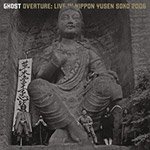Controlling the environment of the listener might seem fascist, but considering the delicate nature of various musical practices, it's almost necessary in this day and age. With the endless chatter, cell phone calls, and texting that take place in live settings, it appears people are increasingly less willing to disconnect with their staggering self-importance in which they are invested and sadly need to be re-instructed on how to act in a live setting. Is it really so much to ask to fully direct your attention to the performing artist on stage? I should think not. Axe grinded.
At the beginning of this particular 2006 performance, Ghost chose, like others have in the past, to lock their audience within the space. The audience was informed that no one was allowed to enter or exit until the finale. (How unfortunate for some sad soul who decided to play the fashionably-late card that evening.) In the case of free improvisation, however, I find this tactic absolutely necessary. Developing an open dialogue is required for the success of a group dynamic, and without the aggravation of discourteously late or bathroom-prone listeners adding to the already existing tension, the desired outcome is much more likely. Additionally, Ghost even added a demanding step for themselves by not allowing any eye contact with one another due to their positioning. Obviously, the prevention of distraction was essential for Ghost.
The performance began in the dark with the closing of the gate, sealing off the space just before the musicians started playing. But the darkness was short lived, as it was more of a mental palate cleanser than an artist statement. The interior became illuminated by projections of patterns, images, and calligraphy created by Overheads, adding visual elements in the sonically immersive environment. This was assuredly a modern meditative ritual. The participants became unified within the sound and space, and with a large enough TV and surround sound speaker system, the effect could be approximated with the DVD version of this performance.
The venue chosen for this performance, a converted warehouse space on Yokohama Bay, has a 13 to 15-second length of reverberation matched to a limestone cave. This natural acoustic adds a spiritual dimension to their sonic explorations, as introductory percussive elements blossom cautiously as filigree, reaching steadily outward and leaving vaporous trails behind them. The lengthy piece then begins to expand and contract, as added instruments address each other -- some braying, some rasping, others tumbling -- reaching a preliminary minor peak around the 20-minute mark, before recessing back into the shadow momentarily to reorganize.
A meditative flute exploration becomes the central figure in the following passage, while otherwordly strains of waterphone, tin whistle, and kaval slowly begin to swell underneath. They engage in an increasingly agitated dialogue, as squeals of guitar rush forward in advance of the introductory piano and voice before once again recoiling. Gentle piano figures maintain the focus for an extended passage, while a guitar rears up and snarls in confrontation until a saxophone squall asserts itself, sending the elements into a frenzied dance. We have now only reached the 50-minute mark, a little over half the performance's length.
One of the most surprising moments occur when a tangible song begins to manifest around the one-hour mark, arising so gently that it doesn't seem out of place from the predominantly instrumental nature of the whole. Frantic piano measures enter and signal the build to the final arc, the climax before the finale. Instruments radiate and fade, extending this climb into a succession of smaller anti-climaxes before finally unleashing full power. It is a dizzying cyclone of sounds that fades as quickly as it arrives, allowing the piano to once again take the lead, this time to the end alongside recorded bells. The exit is as pure and unhurried as the entrance, a suiting conclusion that leaves the listener invigorated by the ritual cleansing.
While the CD features an edited version of the show at just over 56 minutes, the DVD contains the full, nearly one-hour-and-a-half performance, presented visually as documented by four video cameras. I probably don't have to state that this version is better suited to the musical stretching-out on play. The release is unabashedly sumptuous, an incredible document of a recorded milestone in the history of Ghost, one that both artist and Drag City should be exceptionally proud. It would have been nice to have seen packaging more befitting of its contents, perhaps a lovely box or digipak in slipsleeve, instead of a jewel case. But, regardless, the performance is the important element and from which we receive the full measure of Ghost. I honestly can't recommend Overture: Live in Nippon Yusen Soko 2006 highly enough.
More about: Ghost




